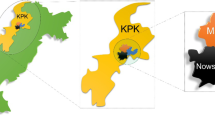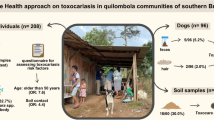Abstract
Toxocara canis, Toxocara cati and Ascaris suum are worldwide-distributed zoonotic roundworms of dogs, cats and pigs, respectively. The epidemiology of these parasites in developed countries is largely unclear. Two countrywide cross-sectional serosurveys were therefore conducted in the Netherlands in 1995/1996 and 2006/2007 to investigate the prevalence, trends and risk factors for human Toxocara and Ascaris infections in the general population. The Netherlands is characterized by high pig production, freedom from stray dogs and virtual absence of autochthonous infections with the human-adapted roundworm Ascaris lumbricoides. Over the 10 years between the two serosurveys, Toxocara seroprevalence decreased significantly from 10.7 % (n = 1159) to 8.0 % (n = 3683), whereas Ascaris seroprevalence increased significantly from 30.4 % (n = 1159) to 41.6 % (n = 3675), possibly reflecting concomitant improvements in pet hygiene management and increased exposure to pig manure-contaminated soil. Increased anti-Toxocara IgGs were associated with increasing age, male gender, contact with soil, ownership of cats, cattle or pigs, hay fever, low education, high income and non-Western ethnic origin. Increased anti-Ascaris IgGs were associated with increasing age, owning pigs, low education, childhood geophagia and non-Dutch ethnic origin. Besides identifying specific groups at highest risk of Toxocara and Ascaris infections, our results suggest that these infections mainly occur through environmental, rather than foodborne, routes, with direct contact with soil or cat and pig ownership being potentially modifiable exposures.



Similar content being viewed by others
References
Baboolal S, Rawlins SC (2002) Seroprevalence of toxocariasis in schoolchildren in Trinidad. Trans R Soc Trop Med Hyg 96(2):139–143
Bethony J, Brooker S, Albonico M, Geiger SM, Loukas A, Diemert D, Hotez PJ (2006) Soil-transmitted helminth infections: ascariasis, trichuriasis, and hookworm. Lancet 367(9521):1521–1532. doi:10.1016/s0140-6736(06)68653-4
De Melker HE, Conyn-van Spaendonck MA (1998) Immunosurveillance and the evaluation of national immunization programmes: a population-based approach. Epidemiol Infect 121(3):637–643
de Wit MA, Koopmans MP, Kortbeek LM, van Leeuwen NJ, Vinje J, van Duynhoven YT (2001a) Etiology of gastroenteritis in sentinel general practices in the Netherlands. Clin Infect Dis 33(3):280–288. doi:10.1086/321875
de Wit MA, Koopmans MP, Kortbeek LM, Wannet WJ, Vinje J, van Leusden F, Bartelds AI, van Duynhoven YT (2001b) Sensor, a population-based cohort study on gastroenteritis in the Netherlands: incidence and etiology. Am J Epidemiol 154(7):666–674
Despommier D (2003) Toxocariasis: clinical aspects, epidemiology, medical ecology, and molecular aspects. Clin Microbiol Rev 16(2):265–272
Deutz A, Fuchs K, Auer H, Kerbl U, Aspock H, Kofer J (2005) Toxocara-infestations in Austria: a study on the risk of infection of farmers, slaughterhouse staff, hunters and veterinarians. Parasitol Res 97(5):390–394. doi:10.1007/s00436-005-1469-5
Eijck IA, Borgsteede FH (2005) A survey of gastrointestinal pig parasites on free-range, organic and conventional pig farms in The Netherlands. Vet Res Commun 29(5):407–414. doi:10.1007/s11259-005-1201-z
El Guamri Y, Belghyti D, Barkia A, Tiabi M, Aujjar N, Achicha A, El Kharrim K, Elfellaki L (2011) Parasitic infection of the digestive tract in children in a regional hospital center in Gharb (Kenitra, Morroco): some epidemiological features. East Afr J Public Health 8(4):250–257
Georges K, Adesiyun A (2008) An investigation into the prevalence of dog bites to primary school children in Trinidad. BMC Public Health 8:85. doi:10.1186/1471-2458-8-85
Haswell-Elkins MR, Leonard H, Kennedy MW, Elkins DB, Maizels RM (1992) Immunoepidemiology of Ascaris lumbricoides: relationships between antibody specificities, exposure and infection in a human community. Parasitology 104(Pt 1):153–159
Holland CV (2015) Knowledge gaps in the epidemiology of Toxocara: the enigma remains. Parasitology:1–14 doi:10.1017/s0031182015001407
Izumikawa K, Kohno Y, Izumikawa K, Hara K, Hayashi H, Maruyama H, Kohno S (2011) Eosinophilic pneumonia due to visceral larva migrans possibly caused by Ascaris suum: a case report and review of recent literatures. Jpn J Infect Dis 64(5):428–432
Kanobana K, Vereecken K, Junco Diaz R, Sariego I, Rojas L, Bonet Gorbea M, Polman K (2013) Toxocara seropositivity, atopy and asthma: a study in Cuban schoolchildren. Trop Med Int Health 18(4):403–406. doi:10.1111/tmi.12073
Kaplan M, Kalkan A, Hosoglu S, Kuk S, Ozden M, Demirdag K, Ozdarendeli A (2004) The frequency of Toxocara infection in mental retarded children. Mem Inst Oswaldo Cruz 99(2):121–125 doi:/S0074-02762004000200001
Kim S, Maekawa Y, Matsuoka T, Imoto S, Ando K, Mita K, Kim H, Nakajima T, Ku K, Koterazawa T, Fukuda K, Yano Y, Nakaji M, Kudo M, Kim K, Hirai M, Hayashi Y (2002) Eosionophilic pseudotumor of the liver due to Ascaris suum infection. Hepatol Res 23(4):306
Krecek RC, Moura L, Lucas H, Kelly P (2010) Parasites of stray cats (Felis domesticus L., 1758) on St. Kitts, West Indies. Vet Parasitol 172(1–2):147–149. doi:10.1016/j.vetpar.2010.04.033
Leles D, Gardner SL, Reinhard K, Iniguez A, Araujo A (2012) Are Ascaris lumbricoides and Ascaris suum a single species? Parasit Vectors 5:42. doi:10.1186/1756-3305-5-42
Lozano MJ, Martin HL, Diaz SV, Manas AI, Valero LA, Campos BM (2004) Cross-reactivity between antigens of Anisakis simplex s.l. and other ascarid nematodes. Parasite 11(2):219–223
Lynch NR, Hagel I, Vargas V, Rotundo A, Varela MC, Di Prisco MC, Hodgen AN (1993) Comparable seropositivity for ascariasis and toxocariasis in tropical slum children. Parasitol Res 79(7):547–550
Nagakura K, Tachibana H, Kaneda Y, Kato Y (1989) Toxocariasis possibly caused by ingesting raw chicken. J Infect Dis 160(4):735–736
Nejsum P, Parker ED Jr, Frydenberg J, Roepstorff A, Boes J, Haque R, Astrup I, Prag J, Skov Sorensen UB (2005) Ascariasis is a zoonosis in Denmark. J Clin Microbiol 43(3):1142–1148. doi:10.1128/jcm.43.3.1142-1148.2005
Nijsse R, Mughini-Gras L, Wagenaar JA, Franssen F, Ploeger HW (2015a) Environmental contamination with Toxocara eggs: a quantitative approach to estimate the relative contributions of dogs, cats and foxes, and to assess the efficacy of advised interventions in dogs. Parasit Vectors 8:397. doi:10.1186/s13071-015-1009-9
Nijsse R, Ploeger HW, Wagenaar JA, Mughini-Gras L (2015b) Toxocara canis in household dogs: prevalence, risk factors and owners’ attitude towards deworming. Parasitol Res 114(2):561–569. doi:10.1007/s00436-014-4218-9
Overgaauw PA, Boersema JH (1996) Assessment of an educational campaign by practicing veterinarians in The Netherlands on human and animal Toxocara infections. Tijdschr Diergeneeskd 121(21):615–618
Overgaauw PA, van Zutphen L, Hoek D, Yaya FO, Roelfsema J, Pinelli E, van Knapen F, Kortbeek LM (2009) Zoonotic parasites in fecal samples and fur from dogs and cats in The Netherlands. Vet Parasitol 163(1–2):115–122. doi:10.1016/j.vetpar.2009.03.044
Permin A, Henningsen E, Murrell KD, Roepstorff A, Nansen P (2000) Pigs become infected after ingestion of livers and lungs from chickens infected with Ascaris of pig origin. Int J Parasitol 30(7):867–868
Pinelli E, Aranzamendi C (2012) Toxocara infection and its association with allergic manifestations. Endocr Metab Immune Disord Drug Targets 12(1):33–44
Pinelli E, Herremans T, Harms MG, Hoek D, Kortbeek LM (2011) Toxocara and Ascaris seropositivity among patients suspected of visceral and ocular larva migrans in the Netherlands: trends from 1998 to 2009. Eur J Clin Microbiol Infect Dis 30(7):873–879. doi:10.1007/s10096-011-1170-9
Pinelli E, Willers SM, Hoek D, Smit HA, Kortbeek LM, Hoekstra M, de Jongste J, van Knapen F, Postma D, Kerkhof M, Aalberse R, van der Giessen JW, Brunekreef B (2009) Prevalence of antibodies against Ascaris suum and its association with allergic manifestations in 4-year-old children in The Netherlands: the PIAMA birth cohort study. Eur J Clin Microbiol Infect Dis 28(11):1327–1334. doi:10.1007/s10096-009-0785-6
Salem G, Schantz P (1992) Toxocaral visceral larva migrans after ingestion of raw lamb liver. Clin Infect Dis 15(4):743–744
Schneider R, Auer H (2015) Incidence of Ascaris suum-specific antibodies in Austrian patients with suspected larva migrans visceralis (VLM) syndrome. Parasitol Res. doi:10.1007/s00436-015-4857-5
Sharghi N, Schantz PM, Caramico L, Ballas K, Teague BA, Hotez PJ (2001) Environmental exposure to Toxocara as a possible risk factor for asthma: a clinic-based case–control study. Clin Infect Dis 32(7):E111–116. doi:10.1086/319593
Smith H, Holland C, Taylor M, Magnaval JF, Schantz P, Maizels R (2009) How common is human toxocariasis? Towards standardizing our knowledge. Trends Parasitol 25(4):182–188. doi:10.1016/j.pt.2009.01.006
Thompson DE, Bundy DA, Cooper ES, Schantz PM (1986) Epidemiological characteristics of Toxocara canis zoonotic infection of children in a Caribbean community. Bull World Health Organ 64(2):283–290
Uga S, Kataoka N (1995) Measures to control Toxocara egg contamination in sandpits of public parks. Am J Trop Med Hyg 52(1):21–24
Umetsu S, Sogo T, Iwasawa K, Kondo T, Tsunoda T, Oikawa-Kawamoto M, Komatsu H, Inui A, Fujisawa T (2014) Intestinal ascariasis at pediatric emergency room in a developed country. World J Gastroenterol 20(38):14058–14062. doi:10.3748/wjg.v20.i38.14058
van der Klis FR, Mollema L, Berbers GA, de Melker HE, Coutinho RA (2009) Second national serum bank for population-based seroprevalence studies in the Netherlands. Neth J Med 67(7):301–308
van Knapen F, Buijs J, Kortbeek LM, Ljungstrom I (1992) Larva migrans syndrome: Toxocara, Ascaris, or both? Lancet 340(8818):550–551
Yentur Doni N, Gurses G, Simsek Z, Yildiz Zeyrek F (2015) Prevalence and associated risk factors of intestinal parasites among children of farm workers in the southeastern Anatolian region of Turkey. Ann Agric Environ Med 22(3):438–442. doi:10.5604/12321966.1167709
Acknowledgments
The authors are grateful to Fiona van der Klis and to the PIENTER study team for their efforts in data collection
Author information
Authors and Affiliations
Corresponding author
Ethics declarations
All procedures performed in studies involving human participants were in accordance with the ethical standards of the institutional and/or national research committee and with the 1964 Helsinki Declaration and its later amendments or comparable ethical standards. PIENTER-1 was approved by the Medical Ethical Committee of the Netherlands’ Organisation for Applied Scientific Research (TNO) in Leiden. PIENTER-2 has received ethical approval by the Medical Ethics Testing Committee of the Foundation of Therapeutic Evaluation of Medicines (METC-STEG) in Almere (ISRCTN 20164309). All participants and parents/legal caretakers of minors involved in both studies provided written informed consent. No person identifying information was generated in this study.
Conflicts of interest
All authors have no conflicts of interest to declare.
Funding
This study was supported by the Netherlands’ Ministry of Health, Welfare and Sport. The funders had no role in the study design, data collection and analysis, decision to publish or preparation of the manuscript.
Additional information
Lapo Mughini-Gras and Margriet Harms contributed equally to this work.
Appendix
Appendix
Rights and permissions
About this article
Cite this article
Mughini-Gras, L., Harms, M., van Pelt, W. et al. Seroepidemiology of human Toxocara and Ascaris infections in the Netherlands. Parasitol Res 115, 3779–3794 (2016). https://doi.org/10.1007/s00436-016-5139-6
Received:
Accepted:
Published:
Issue Date:
DOI: https://doi.org/10.1007/s00436-016-5139-6




